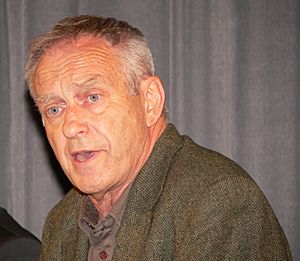Édouard Brézin facts for kids
Quick facts for kids
Édouard Brezin
|
|
|---|---|
 |
|
| Born | 1 December 1938 |
| Nationality | French |
| Alma mater | École Polytechnique École des ponts ParisTech |
| Scientific career | |
| Fields | Physics |
Édouard Brézin, born on December 1, 1938, in Paris, France, is a famous French theoretical physicist. He was a professor at Pierre and Marie Curie University (also known as Université Paris 6). He worked at the theoretical physics lab of the École Normale Supérieure starting in 1986.
Contents
A Look at Édouard Brézin's Life
Édouard Brézin was born in Paris, France. During World War II, his family faced challenges. His father was a soldier and was captured, but he managed to escape. To stay safe, the family used different names, and young Édouard was hidden by farmers.
He studied at a top French school called École Polytechnique. After that, he earned his PhD. For many years, until 1986, he worked at the theory division of the French Atomic Energy Commission in Saclay.
Contributions to Physics
Brézin made important contributions to two main areas of physics. One area is condensed matter physics, which looks at the overall physical properties of materials. The other is high energy physics, which studies the smallest particles and forces in the universe.
He was a leader in understanding something called "critical behavior." This is how materials change their properties very suddenly, like when water turns into ice. He developed ways to predict these changes. Brézin also used special math tools, called "field theory techniques," to study materials. This helped improve our understanding of magnetism and the quantum Hall effect, which is about how electrons behave in strong magnetic fields.
Awards and Recognition
Édouard Brézin has received many honors for his work. He became a member of the French Academy of Sciences in 1991 and was its president from 2005 to 2006.
He is also a member of important scientific groups around the world:
- The United States National Academy of Sciences (since 2003)
- The American Academy of Arts and Sciences (since 2002)
- The Royal Society in the UK (since 2006)
- The Academia Europaea (since 2003)
He has also received high honors from France, including being a commander in the French National Order of Merit and an Officer of the Legion of Honor.
In 2011, he was awarded the Dirac Medal from the International Centre for Theoretical Physics. He shared this award with John Cardy and Alexander Zamolodchikov. In 2004, he also won the President's Medal from the Institute of Physics.
He is currently the Chair of the Cyprus Research and Educational Foundation.
Brézin's Research Work
Édouard Brézin's research mainly focused on quantum field theory. This is a way to describe how tiny particles interact. He used it to understand statistical physics, which studies how large groups of particles behave.
He explored how "renormalization group" theory helps explain critical phenomena. He showed how materials behave at very low temperatures when their symmetry breaks. He also found ways to make accurate predictions using a method called "instantaneous method."
Brézin applied his field theory skills to problems in condensed matter physics. For example, he studied how a normal metal changes into a special type of superconductor when a magnetic field is applied.
Later, he became interested in theories with many "colors" (a concept in physics). This led him to connect two-dimensional quantum gravity with random matrices. He showed that these models are linked to special math problems called "integrable hierarchies." He also worked on showing that the way eigenvalues (special numbers) are related in random matrices is universal, meaning it applies widely.
Books by Édouard Brézin
- The large N expansion in quantum field theory and statistical physics, written with S Wadia, published by World Scientific (1993)
- Introduction to statistical field theory, published by Cambridge University Press (2010)
See also
- List of members of the National Academy of Sciences

